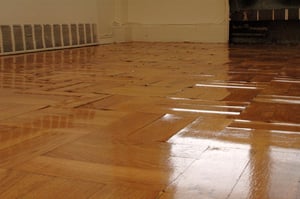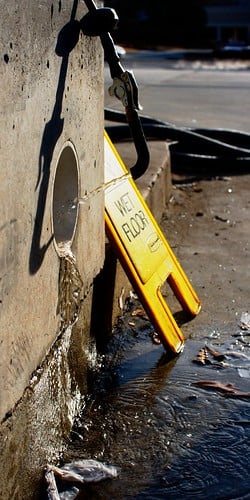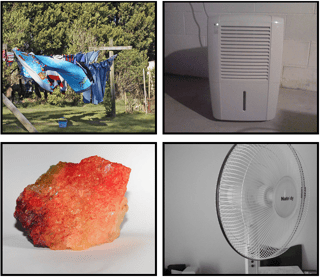A Great After-the-Flood Checklist
We thought we'd share a blog post from our manufacturing site that will help you understand what you need to do in the aftermath of a leak or flood.
After a leak, you will need to clean and dry your property quickly. Nobody wants mold to grow on their carpets, have their wood floors warp, see their electronics destroyed, or allow any of the other consequences of water damage to take root in their home or business. That is why it is so important to know how to properly stop that water flow, dry your property, and re-mediate potential water damage.
Here are a few tips to help ensure a quick dry.
Isolate the Leak and Shut Down the Power

Whether you are in the middle of a storm that is flooding water onto your floors or tending to a broken pipe gushing water all over, it is incredibly important that you isolate the area. Setting up some kind of stopgap will help reduce the cost in time and money that comes with water clean-up. Another benefit of making sure you isolate the water and stop it from spreading is that this presents the opportunity to take care of any electronics that may be in the path of the water, preventing the risk of electrocution.
Stopping the spread of water is not easy if you do not have the tools with which to do so. If you have some kind of flood barrier to place down, then you can block the flow of the water and keep it away from the rest of your property. But if you don’t have any kind of flood barrier, you’ll need to improvise and do the best you can. Regardless of your flood-sparing tools, the best thing to do is to turn off or unplug any electronics that are in the path or potential path of the water. Keeping water contained as much as possible will minimize what needs to be dried after the leak is taken care of or the flooding ends and unplugging and turning off electronics will ensure no one gets electrocuted if the water meets the electricity.
Clear Out Standing Water
It may seem like a simple task once the water has stopped flowing, but clearing out any standing water in your home or business requires the right tools. A supply of good super-absorbents, like the OSMO products in our emergency kit will soak up gallons of water and save you from having a bigger soggy mess. Vacuums made for water applications, like shop vacs or wet/dry vacs are very efficient at cleaning up large puddles of water or standing liquid. The liquid can then be dumped into either a sink or drain so that it isn’t left soaking in where it isn’t wanted. If there is a significant amount of water, a sump pump is going to be the best option for clearing a massively flooded area.
Standing water is a hotbed for germs and other microscopic nasties, so be careful when you do start clearing the water. Wear protective gear, make sure you know what’s under the water, and take your time: nobody wants to trip and splash around in a flooded basement, after all.
Remove and Dry Soaked Property
Once you’ve cleaned out any standing water, you’ll want to clear out anything that got wet during the incident. If the property can be dried, move it to a dry place rather than leaving it in the middle of a wet room. However, if you know there is property that is not salvageable and which cannot be dried back to its original (or close to original) condition, then there’s no point in keeping it inside, either. Place it in the trash or dumpster, or call a company to come and remove it for you if there is too much or the piece(s) are too large. The faster the wet materials can be removed, the sooner the drying process can start.
Once you have determined what is salvageable, be it personal or commercial goods, you can then take steps to dry it as best you can. Air drying is always a good option, provided the humidity will allow it. Using a hairdryer is always a classic way to dry wet items as well. Leaving clothing and cloth out for the sun has been used to dry them for as long as laundry has existed. Many things are able to be in contact with water, and may even be wet for a period of time, before the damage becomes permanent.
Dehumidify and Dehydrate
Having soaked or vacuumed up all the excess water on the floor and removed any wet or damaged goods, it’s now time to take care of the air. No matter how much water has spilled out, be it a large flood or a slowly leaking pipe, moisture will make its way into the air as well as into your carpeting. Leaving moisture in the air will make renovations and repairs to what was water damaged more difficult. It’s important to dry out the air in a flooded area once the water has been removed as much as possible.
 The best way to clear the humidity out of the air is with a dehumidifier, a relatively expensive piece of electronic equipment that is useful for exactly this kind of situation. If you do not have access to a dehumidifier, then there are other options for extracting the moisture out of the air. Create a proper airflow by opening windows and turning on any fans you have, assuming the outside humidity is lower than that inside. Using desiccants (which are hydroscopic substances used as drying agents), such as charcoal or rock salt, can also help absorb the water in the air. Pour some into several dishes and set those dishes around the affected area. By diminishing the levels of humidity in the air, you lower the chance of mold or other growths forming on wet or damp patches.
The best way to clear the humidity out of the air is with a dehumidifier, a relatively expensive piece of electronic equipment that is useful for exactly this kind of situation. If you do not have access to a dehumidifier, then there are other options for extracting the moisture out of the air. Create a proper airflow by opening windows and turning on any fans you have, assuming the outside humidity is lower than that inside. Using desiccants (which are hydroscopic substances used as drying agents), such as charcoal or rock salt, can also help absorb the water in the air. Pour some into several dishes and set those dishes around the affected area. By diminishing the levels of humidity in the air, you lower the chance of mold or other growths forming on wet or damp patches.
Stay Prepared
A key factor in being able to quickly dry out your home or business after any kind of water event is to be prepared. Having the proper tools on hand (absorbent materials, a wet/dry vac, a dehumidifier, etc.) is one of the first steps that can be taken to protect a home or business from catastrophic water damage. Drying off your property after the fact is not as easy; it is much easier to be proactive with tools to stop the spread of water before it can cause too much damage. A little preparation can go a long way.
Stay Dry! We hope this information is useful.
Waterslayer Team
